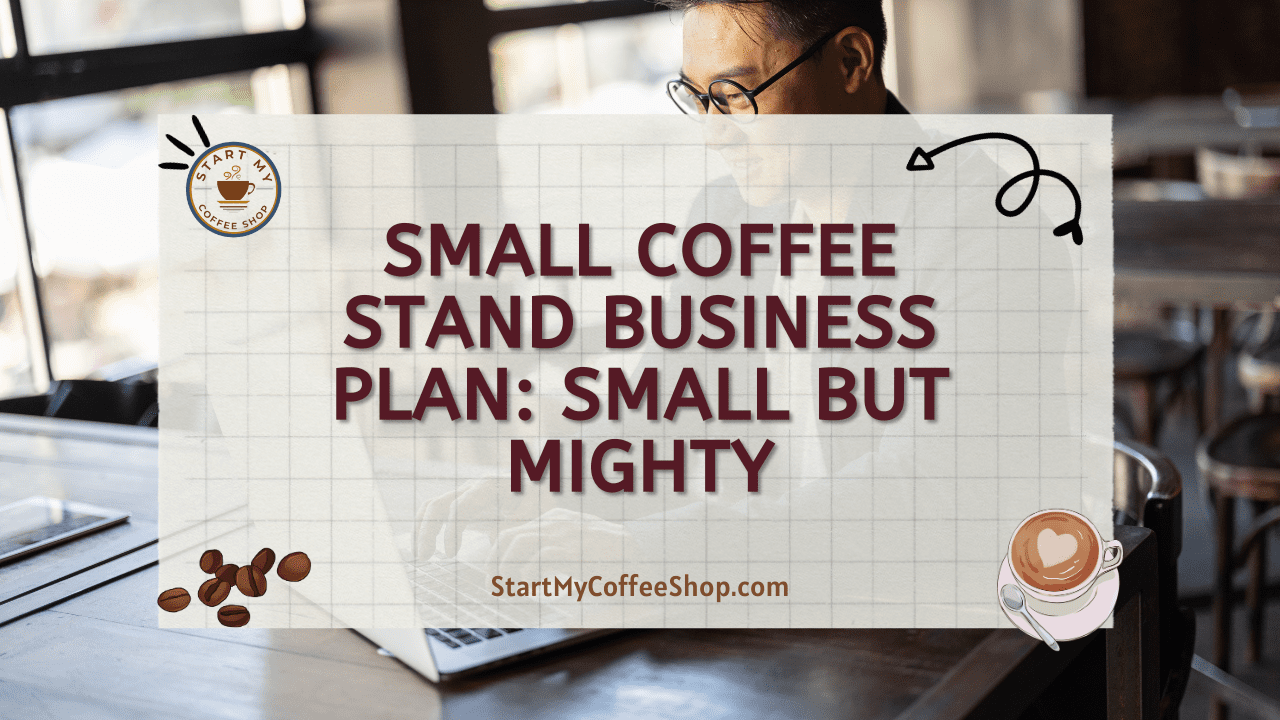In a world fueled by caffeine, the coffee industry continues to thrive, offering a vast array of opportunities for enterprising individuals. One such opportunity lies in starting a small coffee stand. These compact and convenient setups have gained popularity due to their low startup costs, flexibility, and ability to cater to customers on the go.
The small coffee stand business plan outlines the vision, target market, unique offerings, and financial projections. It details the day-to-day operations, marketing strategies, and contingency plans. Don’t forget to add some sections about your company and the products and services you offer.
In this article, I will outline the essential elements of creating a comprehensive business plan for a small coffee stand.
Executive Summary
Within the executive summary, it is essential to highlight key details that showcase your vision and set you apart from competitors. Start with a clear mission statement that encapsulates the purpose and values of your coffee stand. Define your target market by outlining the demographics, preferences, and needs of your ideal customers.

To make a lasting impression, emphasize your unique selling proposition (USP). What makes your coffee stand stand out? Is it your signature blends, commitment to sustainability, or exceptional customer service? Clearly articulate your USP to differentiate yourself in the market.
Furthermore, provide a glimpse into your financial projections, offering a glimpse of the potential profitability and return on investment for interested parties.
Crafting a compelling executive summary requires succinct yet persuasive language, effectively capturing the essence of your coffee stand venture and igniting the curiosity of potential stakeholders.
Read more about: Mobile Coffee Business Plan: The Mobile Barista Blueprint
Company Description
Start by introducing your business name, which should reflect your brand identity and resonate with your target audience. Next, discuss the legal structure of your business, whether it’s a sole proprietorship, partnership, or corporation. Clarify the ownership and management structure to give readers a clear understanding of the organizational framework.
Detail the location of your coffee stand, highlighting the advantages and benefits of the chosen spot. Consider factors such as foot traffic, accessibility, and proximity to potential customers, offices, or popular attractions.
Describe the coffee products and services you plan to offer, including the different blends, brew methods, and beverage options. Emphasize any unique flavor combinations or innovative menu items that set you apart from competitors.
Moreover, emphasize your unique selling proposition (USP). This could be sourcing locally grown and sustainable beans, showcasing fair trade practices, or prioritizing organic ingredients. If exceptional customer service is a key aspect of your business, explain how you plan to go above and beyond to create memorable experiences for your customers.
Market Analysis
Start by gaining comprehensive insights into the coffee industry and its current trends. Understand the dynamics of the market, including consumer preferences, emerging brewing methods, and popular flavor profiles.
Identify your primary target audience and delve into their demographics, such as age, gender, location, and income level. Determine their preferences and buying habits, whether they lean towards specialty coffees, prefer convenience, or prioritize sustainable practices.
Analyzing your competition is crucial. Identify both direct competitors, such as nearby coffee shops or other coffee stands, and indirect competitors, such as convenience stores or cafes offering coffee to-go. Study their strengths, weaknesses, pricing strategies, and unique selling points.
Recognize the challenges and opportunities within the coffee industry. Stay informed about changing consumer demands, evolving coffee trends, and emerging technologies. This knowledge will allow you to adapt and innovate, positioning your coffee stand as a frontrunner in the market.
Consider conducting thorough market research, you will gain valuable insights that will inform your business decisions and help you develop a strategic plan to attract and retain your target audience.
Organization and Management

In this section of your business plan, it is crucial to outline the organizational structure of your coffee stand and define the roles and responsibilities of key team members. Start by providing an overview of your management team and their qualifications.
For each position, clearly define the responsibilities and qualifications required. For example, the barista may be responsible for preparing and serving coffee, maintaining equipment, and providing excellent customer service. Highlight the importance of skills such as coffee brewing expertise, latte art proficiency, and knowledge of different coffee varieties.
If you are a sole proprietor, emphasize your skills and expertise that make you well-suited to run the coffee stand. Discuss your experience in the coffee industry, your understanding of customer preferences, and your ability to manage day-to-day operations effectively. Investors and lenders will want assurance that you have the necessary expertise to drive the business toward improvement.
Consider including an organizational chart to visually represent the hierarchy and reporting structure within your coffee stand. This will help stakeholders understand how different roles and positions interact.
Try outlining the structure of your organization and showcasing the qualifications and experience of your team, you instill confidence in potential investors and lenders. Demonstrating that you have the necessary expertise and a capable team in place will greatly contribute to the overall credibility of your coffee stand business.
Read more about: Mobile Coffee Bar Business Plan: On-the-Go Brews
Product Line and Menu
Start by highlighting your signature beverages, those specialty concoctions that are exclusive to your coffee stand. Describe the flavors, ingredients, and presentation that make them stand out. Whether it’s a creatively named latte with unique flavor combinations or a refreshing cold brew with a twist, paints a vivid picture that entices customers.
Discuss the different coffee blends you offer, emphasizing their origins, flavor profiles, and roast levels. Explain how each blend caters to different tastes and preferences, showcasing your commitment to offering a diverse range of options.
Outline the brewing methods you employ, such as pour-over, espresso-based, or French press. Explain the significance of each method in bringing out the distinct characteristics of the coffee and creating a memorable sensory experience for customers.
Additionally, if you plan to offer any additional products or food items, detail them in this section. Whether it’s freshly baked pastries, gourmet sandwiches, or artisanal snacks, highlight how these offerings complement and enhance the coffee experience.
Throughout the description of your coffee offerings, emphasize the quality and uniqueness of your products. Discuss your commitment to sourcing high-quality beans, partnering with local suppliers, or utilizing sustainable practices. Highlight any certifications or awards that validate the excellence of your products.
Marketing and Sales Strategy
Begin by identifying your target audience and their preferred communication channels. Are they active on social media platforms like Instagram or Facebook? Do they rely on local community newsletters or word-of-mouth recommendations? Tailor your marketing efforts to reach them effectively.
Utilize online strategies such as social media marketing to showcase your coffee stand’s unique offerings. Share captivating visuals, engaging content, and behind-the-scenes glimpses to generate excitement and curiosity. Encourage user-generated content by running photo contests or featuring customer testimonials. Engage with your audience by responding to comments and inquiries promptly.
Incorporate offline strategies as well, such as forging local partnerships. Collaborate with nearby businesses, offices, or event organizers to cross-promote and expand your reach. Consider offering discounts or promotions to incentivize repeat business and create a sense of loyalty among customers. Implement a loyalty program that rewards frequent visitors, encouraging them to return and refer others.
Harness the power of word-of-mouth referrals by providing exceptional customer service and memorable experiences. Encourage customers to share their positive experiences with friends and family. Consider offering referral incentives to further motivate them.
Regularly evaluate the effectiveness of your marketing and sales strategies and make adjustments as needed. Monitor customer feedback, track sales data, and stay updated on industry trends to continuously refine and improve your approach.
Financial Projections

Start by developing a startup budget, outlining the costs of equipment, supplies, permits, licenses, and initial marketing expenses. Next, generate a sales forecast based on your market research and pricing strategy. Estimate your potential revenue based on projected customer demand and pricing models.
Outline your projected expenses, including rent, utilities, payroll, and ingredient costs. Factor in both fixed and variable expenses to accurately reflect the ongoing operational costs of your coffee stand. To provide a clear picture of your financial expectations, generate a cash flow statement and income statement.
Regularly review and update your financial projections as your business evolves. This will help you monitor your progress, make informed financial decisions, and identify any areas that require adjustments or improvements.
Read more about: Major Risks of Opening a Coffee Shop: The Bitter Brew
Operations and Logistics
In the day-to-day operations section, provide a clear explanation of how your coffee stand will function. Describe the process of sourcing coffee beans, including your criteria for selecting suppliers and maintaining consistent quality. Detail your storage methods to ensure the freshness and longevity of your coffee beans. Address inventory management practices to avoid stockouts or wastage.
Outline your planned hours of operation, considering peak customer demand and any specific events or occasions that may require adjusted schedules. Discuss the staffing requirements, specifying the roles and responsibilities of each team member.
Additionally, address the logistics of setting up and dismantling your coffee stand. Detail the equipment and infrastructure needed, such as coffee machines, brewing tools, and service counter setup. Address any permits or regulations you need to comply with, ensuring that you operate legally and safely.
Risk Analysis and Contingency Plan
Anticipate factors that could impact your operations, such as shifting consumer preferences, an influx of new competitors, or disruptions in the supply chain.
Develop a comprehensive contingency plan to mitigate these risks. Identify alternative strategies or action steps that can be implemented to adapt and respond to unforeseen circumstances. For example, if consumer preferences change, you may need to adjust your menu or introduce new offerings to stay relevant. If faced with increased competition, you might consider implementing targeted marketing campaigns or strengthening customer loyalty programs.
Additionally, establish relationships with alternative suppliers to minimize the impact of potential supply chain disruptions. Diversify your sourcing options or explore local partnerships to ensure a steady supply of high-quality coffee beans.
By proactively identifying risks and developing a contingency plan, you demonstrate your preparedness and ability to navigate challenges. This will instill confidence in potential investors, lenders, and stakeholders, knowing that you have considered various scenarios and have strategies in place to mitigate any potential setbacks.
Conclusion
Summarize the key points of your business plan, reiterating your vision and goals. Emphasize the unique value your coffee stand brings to the market and your commitment to providing exceptional coffee experiences. End on an optimistic note, expressing your confidence in the potential growth of your small coffee stand venture.
Summary
Launching a small coffee stand is an exciting endeavor that allows you to share your passion for coffee with customers on the go. Keep in mind that dedication, creativity, and exceptional customer service will be the key ingredients to perking up your profits and establishing a thriving coffee stand in today’s competitive market. So, go ahead, brew your dreams into reality, and watch your small coffee stand become a hub of caffeine-fueled delight!
Frequently Asked Questions

Q: Do I need any special permits or licenses to operate a coffee stand?
A: Yes. These may include a business license, health department permits, food handling permits, and zoning permits. Check with your local authorities for specific requirements.
Q: How can I attract customers to my coffee stand?
A: Utilize social media platforms, collaborate with local businesses, offer promotions, and focus on providing exceptional customer service. Engaging signage and creating a cozy ambiance can also help draw attention to your stand.
Q: Can I offer food items in addition to coffee at my stand?
A: Yes. Consider pastries, sandwiches, or light snacks. However, ensure compliance with local health and safety regulations for food preparation and handling.
To learn more on how to start your own coffee shop, check out my startup documents here.
Disclaimer: The information provided by StartMyCoffeeShop.com (“The Site”) is for general informational purposes only. All information on the Site is provided in good faith. However, we make no representation or warranty of any kind, express or implied, regarding the accuracy, adequacy, validity, reliability, availability, or completeness of any information on the Site. Under no circumstance shall we have any liability to you for any loss or damage of any kind incurred as a result of the use of the Site or Reliance on any information provided on the Site. Your use of the Site and reliance on any information on the Site is solely at your own risk. This blog post is for educational purposes only and does not constitute legal advice. Please consult a legal expert to address your specific needs. Terms and Conditions. (https://startmycoffeeshop.com/terms-and-conditions/)

Hi! I’m Shawn Chun
My adventure in coffee began when I first launched my first coffee shop back in the early 2000s. I had to figure out so many things on my own and to make it worse within 2 years of opening two large corporate coffee chains moved in just blocks away from me!
As I saw smaller and even some larger coffee shops in the neighborhood slowly lose customers to these giant coffee chains and slowly close up shop, I knew that I had to start getting creative…or go out of business.
I (like you may be) knew the coffee industry well. I could make the best latte art around and the foam on my caps was the fluffiest you have ever seen. I even had the best state-of-the-art 2 group digital Nuova Simonelli machine money could buy. But I knew that these things alone would not be enough to lure customers away from the name brand established coffee shops.
Eventually, through lots of trial and error as well as perseverance and creativity I did find a way to not only survive but also thrive in the coffee/espresso industry even while those corporate coffee chains stayed put. During those years I learned to adapt and always faced new challenges. It was not always easy, however, in the end, I was the sole survivor independent coffee shop within a 10-mile radius of my location. Just two corporate coffee chains and I were left after that year. All told the corporate coffee chains took down over 15 small independent coffee shops and kiosks and I was the last one standing and thriving.
Along the years I meet others with the same passion for coffee and I quickly learned that it is not only “how good a barista is” that makes a coffee shop successful, but the business side of coffee as well.
Hence why I started this website you are on now. To provide the tools and resources for up and coming coffee shop owners to gain that vital insight and knowledge on how to start a coffee shop successfully.
Stick around, browse through my helpful blog and resources and enjoy your stay! With lots of LATTE LOVE!
Shawn







